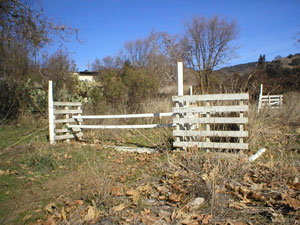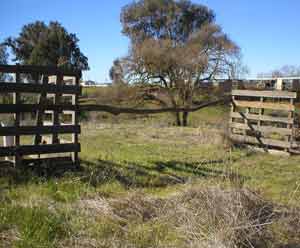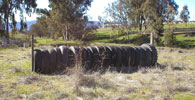Creative / Novel / Budget Ideas
Budget Jumps....
- Jump Poles -- Use pvc 4" solid drain pipe and fill it with a 2x4 for weight. They will only be 10 ft. but the are always white and look great with sleeves!
- Jump Pole Sleeves -- You can purchase contact paper in colors or patterns and use it to add stripes to your jump poles, instead of painting them.
 Jump standards -- you can use 10 ft. pvc drain pipe for upright
standards. Cut them in half and drill one extra set of holes to make the jump cups fit better. Approximate cost
$5.00 for two poles. In the picture I used pvc fence posts, the drain pipe doesn't look as nice, but it is cheaper. Just after Christmas, you can pick up plastic Christmas tree stands on clearance
to hold the pvc standard poles. Two stands are about $4.00. Fill the bottom of
the pole and the stand with sand or concrete for support. Total cost $9.00 dollars for two jump stands. Caution: too much cement makes them very heavy, try dry wall compond or something a little lighter.
Jump standards -- you can use 10 ft. pvc drain pipe for upright
standards. Cut them in half and drill one extra set of holes to make the jump cups fit better. Approximate cost
$5.00 for two poles. In the picture I used pvc fence posts, the drain pipe doesn't look as nice, but it is cheaper. Just after Christmas, you can pick up plastic Christmas tree stands on clearance
to hold the pvc standard poles. Two stands are about $4.00. Fill the bottom of
the pole and the stand with sand or concrete for support. Total cost $9.00 dollars for two jump stands. Caution: too much cement makes them very heavy, try dry wall compond or something a little lighter.
-
 Use two pallets, screwed together like an "L" for standards, use 4" pvc gutter ends for jump
cups. Sometimes jump cups will attach to the wood that Use two pallets, screwed together like an "L" for standards, use 4" pvc gutter ends for jump
cups. Sometimes jump cups will attach to the wood that  supports the pallet
boards. This makes a low, 3ft. triple combination fence. It is also
easy to adjust as a hogs back type fence or oxer. If you want bigger
standards, you can attach pvc standards described above. In the picture I use 10 ft. pvc gutter's cut in half as the upright. these are white washed. Left, is a natural pallet. Caution, be careful how you set logs in the pallets, the log should be cut or set so it can fall freely. If you don't understand what I'm saying, email me!!!! supports the pallet
boards. This makes a low, 3ft. triple combination fence. It is also
easy to adjust as a hogs back type fence or oxer. If you want bigger
standards, you can attach pvc standards described above. In the picture I use 10 ft. pvc gutter's cut in half as the upright. these are white washed. Left, is a natural pallet. Caution, be careful how you set logs in the pallets, the log should be cut or set so it can fall freely. If you don't understand what I'm saying, email me!!!!

- Recycle old tires -- here is our tire jump. no rims, and ground poles to hold them.
- Recycled Rubber Mats -- Call your local rock quarry for rolls of rubber for stall mats and barn aisle ways. We matted our 24 x 36 barn for
free. You will need a 1 ton flat bed truck and a tractor to pull the roll from the truck.
-
Recycled
Plastic Rubber Arena Footing -- Fox and Markowitz in San Jose,
California, sells recycled, category 2 plastics for arena footing.
The plastic I had floats away in the rainy weather. I have now had rubber
from West Coast Rubber Recycling, www.groundrubber.com.
Talk to Cameron Wright and tell him I sent you. If you
walk in sandy arenas, you will really appreciate the texture of rubber. It is soft, but because it is irregular shaped, the small, soft
pieces lock together when you step on it, and your foot "rolls over"
the footing instead of "sinking into" it. It is great for saving
ligaments and tendons, where sand places great stress on the elastic tissues of
the joints. We have a horse with a ligament injury who on subsequent
x-rays does not show any evidence of the ligament tear.
-
Composted Manure -- We use compost accelerator to break down the manure
in 14 to 21` days. It is a completely natural product. Composting
also helps diminish the fly population, as the heat of composting kills the
insect eggs.
-
Mud Control -- Call your local recyclers for clean, chipped wood for mud control and for footing.
Notes of caution: Some horses may eat the chip, ask to make sure the
chip does not contain poisonous trees or shrubs such as, oleander or yew. You should also run a magnet over the chip. Remember that fences and signs are often fastened to trees and the nails or
tacks can be in the chip.
-
Medication boot -- Make using a rubber tire inner tube and duct tape. We have a draft horse, and you can not buy
barrier boots for drafts. Also, in the dry weather his feet get so hard,
we need to use these boots overnight to soften his hoof for trimming.
-
Plastic Shoes -- I have just found a plastic shoe for drafts at www.hoof-it.com.
I am trying them out this year. My thoroughbred has one foot with an under run
heel, two years in a row, when the weather dries out one heel becomes
sore. I am also trying these shoes on him. Okay, now I am using what my
farrier ordered, and they help a horse with good feet, structurally, or on less
than perfect in the winter months when the hooves are soft. You may still
need a steel or aluminum shoe in the dry weather. The shoes are least
expensive at www.plastichorseshoes.com.
7/05 I have been now using the plastic shoes for 7 years, on drafts, TB's and
all around horses -- on the trails, jumping, field hunting and cross country
eventing. I love them and the horses seem to appreciate the flexibility of
them as well. When switching back to steel, the horses seem to move
slightly stiffer on harder ground. I'm assuming becuase there is some cushion
with the plastic. The plastics also wear less than steel. It is
pretty amazing!
-
Glue-on Plastic Shoes -- I have a thoroughbred with badly under-run
heels. We have been trying to leave him barefoot, so I can rasp at the toe
and also keep the heels from running under. Winter months were a
perfect time to start this, as the ground and the feet were very moist, making
the hoof more malleable. I am working with my vet and farrier who are
watching what I am doing on a day-to-day basis and advising me every couple of
weeks. This means I don't want to put shoes on the horse, as I need to
keep gradually rasping back his toe, trying to move back his
"break-over". However, I want to jump and do
some cross country, and he just doesn't seem to be that comfortable barefoot out
of the sand arena.
I've done alot of research about glue on shoes, and decided to try the Vettec product, Adhere. I glued a set of used plastic shoes on him as an experiment.
- Day one -- The glueing was easy. The distributor in Salinas also gave me
two promotional videos from Vettec about the products and how to use
them. The quality was excellent; it was short and to the point. after
watching the video, the glueing was easy. I used the small glue guns
(20cc); I bought three. The first shoe had about 20cc, the second shoe
had about 30cc.
After the glue set, I rasped the shoe and glue smooth, then I turned
my horse out. All seemed fine. More than fine, he actually seemed more
comfortable by the was he started running and jumping and goofing off.
- Day two -- I rode in the flat, but on uneven ground. I put
bell-boots on his feet, just incase my horse caught the heel of the
shoe. He was very comfortable. I lost one of the shoes after about
15/30 minutes of walk, trot, and canter on grass and packed ground. I
inspected the shoe, and it was clear I had not put enough glue on
it. The other shoe stayed on fine. It was also clear, that
the horse had been in the pond on my property in the night. I could
tell because of the mud that was under the shoe, and the only place to get
mud was in the pond. I think this is sign that with enough glue, these
probably stay on pretty well. So, I need to get more glue.
- day.....They didn't stay on very well. I think it is my technique. It is really a difficult thing to make the hoof dry, even with alcohol. I love the concept, but I almost got my own foot glued to the rubber barn mat!!!
Here's a blog link that might be helpful! I can afford a horse.... amber@equestriantraining.com
Use the "Back" button on your browser to return to the homepage |

